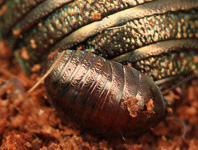Abstract
Aphanius irregularis, new species, is described from the spring Kaklık in the Büyük Menderes River drainage in south-western Anatolia. Males of A. irregularis are distinguished from males of other species of the A. anatoliae group by having irregularly set and shaped dark-brown flank-bars often fused to each other, forming rows of vertically elongated silvery blotches and many small silvery spots or fields of small vermiculation, disconnected from silvery bar interspaces on flank. Males of A. irregularis are distinguished from males of some other species of the A. anatoliae group by having a wide, dusty grey or black anal-fin margin, often interrupted in small individuals; a narrow, white stripe or a series of white spots on the black dorsal-fin base; and often some white blotches in the middle of the dorsal fin. Females of A. irregularis are distinguished by having a vermiculate brown colour pattern, usually with a mid-lateral series of short stripes. The available molecular genetic data suggest that A. irregularis is closely related to A. maeandricus, which occurs in other springs in the Büyük Menderes River drainage. Geological data suggest that both spring complexes have not been connected until they were caught by the Büyük Menderes River in the Late Quaternary, no more than 0.8 million years ago.
References
Akşıray, F. (1948) Türkiye Cyprinodontidleri hakkında I. Türkische Cyprinodontiden I. Revue de la Faculté des Sciences de I’Université d’Istanbul, 13, 97–142.
Behrens-Chapuis, S., Herder, F., Esmaeili, H.R., Freyhof, J., Hamidan, N.A., Özuluğ, M., Šanda, R. & Geiger, M.F. (2015) Adding nuclear rhodopsin data where mitochondrial COI indicates discrepancies—can this marker help to explain conflicts in cyprinids? DNA Barcodes, 3, 187–199.
https://doi.org/10.1515/dna-2015-0020Coyne, J.A. & Orr, H.A. (2004) Speciation. Sinauer Associates, Sunderland, 545 pp.
Erol, O. (1984) Geomorphology and neotectonics of the pluvial lake basins in the Taurus Belt and South Central Anatolia. In: Tekeli, O. & Göncüoğlu, C. (Eds.), Geology of the Taurus Belt International Symposium, Ankara, 1984, pp. 119–124.
Freyhof, J., Özuluǧ, M. & Saç, G. (2017) Neotype designation of Aphanius iconii, first reviser action to stabilise the usage of A. fontinalis and A. meridionalis and comments on the family group names of fishes placed in Cyprinodontidae (Teleostei: Cyprinodontiformes). Zootaxa, 4294 (5), 573–585.
https://doi.org/10.11646/zootaxa.4294.5.6Gavrilets, S. (2003) Perspective: Models of speciation: What have we learned in 40 years? Evolution, 57, 2197–2215.
https://doi.org/10.1111/j.0014-3820.2003.tb00233.xGeiger, M.F., Herder, F., Monaghan, M.T., Almada, V., Barbieri, R., Bariche, M., Berrebi, P., Bohlen, J., Casal-Lopez, M., Delmastro, G.B., Denys, G.P.J., Dettai, A, Doadrio, I., Kalogianni, E., Kärst, H., Kottelat, M., Kovačić, M., Laporte, M., Lorenzoni, M., Marčić, Z., Özuluğ, M., Perdices, A, Perea, S., Persat, H., Porcelotti, S., Puzzi, C., Robalo, J., Šanda, R., Schneider, M., Šlechtová, V., Stoumboudi, M., Walter, S. & Freyhof, J. (2014) Spatial heterogeneity in the Mediterranean Biodiversity Hotspot affects barcoding accuracy of its freshwater fishes. Molecular Ecology Resources, 14, 1210–1221.
https://doi.org/10.1111/1755-0998.12257Gulecal-Pektas, Y. & Temel, M. (2017) A Window to the subsurface: Microbial diversity in hot springs of a sulfidic cave (Kaklik, Turkey). Geomicrobiology Journal, 34, 374–384.
https://doi.org/10.1080/01490451.2016.1204374Güçlü, S.S., Küçük, F., Ertan, Ö.O. & Güçlü, Z. (2013) The Fish Fauna of the Büyük Menderes River (Turkey): Taxonomic and zoogeographic features. Turkish Journal of Fisheries and Aquatic Sciences, 13, 685–698.
https://doi.org/10.4194/1303-2712-v13_4_14Gürer, Ö.F., Sarica-Filoreau, N., Özburan, M., Sangu, E. & Doğan, B. (2009) Progressive development of the Büyük Menderes Graben based on new data, western Turkey. Geological Magazine, 146, 652–673.
https://doi.org/10.1017/S0016756809006359Hebert, P.D.N., Ratnasingham, S. & de Waard, J.R. (2003) Barcoding animal life: cytochrome c oxidase subunit 1 divergences among closely related species. Proceedings of the Royal Society B: Biological Sciences, 270, 96–99. [S96–S99]
https://doi.org/10.1098/rsbl.2003.0025Hrbek, T., Küçük, F., Frickey, T., Stölting, K.N., Wildekamp, R.H. & Meyer, A. (2002) Molecular phylogeny and historical biogeography of the Aphanius (Pisces, Cyprinodontiformes) species complex of central Anatolia, Turkey. Molecular Phylogenetics and Evolution, 25, 125–137.
https://doi.org/10.1016/S1055-7903(02)00203-8
Kazanci, N., Dündar, S., Alçiçek, M.C. & Gürbüz, A. (2009) Quaternary deposits of the Büyük Menderes Graben in western Anatolia, Turkey: Implications for river capture and the longest Holocene estuary in the Aegean Sea. Marine Geology, 264, 165–176.
https://doi.org/10.1016/j.margeo.2009.05.003Kottelat, M. & Freyhof, J. (2007) Handbook of European freshwater fishes. Kottelat, Cornol and Freyhof, Berlin, xiv + 646 pp.
Laurito, M., Oliveira, T.M.P. de, Almirón, W.R. & Sallum, M.A.M. (2013) COI barcode versus morphological identification of Culex (Culex) (Diptera: Culicidae) species: a case study using samples from Argentina and Brazil. Memorias do Instituto Oswaldo Cruz, 108 (Supplement 1), 110–122.
https://doi.org/10.1590/0074-0276130457Özler, H.M. (2015) Hydrogeology of the Kaklik (Denizli) Aquifer in Turkey. Procedia Earth and Planetary Science, 15, 345–352.
https://doi.org/10.1016/j.proeps.2015.08.087Parichy, D.M. (2003) Pigment patterns: fish in stripes and spots. Current Biology, 13, 947–950. [R947–R950]
https://doi.org/10.1016/j.cub.2003.11.038Pfleiderer, S., Geiger, M. & Herder, F. (2014) Aphanius marassantensis, a new toothcarp from the Kızılırmak drainage in northern Anatolia (Cyprinodontiformes: Cyprinodontidae). Zootaxa, 3887 (5), 569–582.
https://doi.org/10.11646/Zootaxa.3887.5.4Pichler, C., Ringler, E., Weissenbacher, A., Affenzeller, M., Tribsch, A., Freyhof, J., Erk’akan, F. & Gollman, G. (2014) Genetic and morphological characterization of a newly found Aphanius population (Cyprinodontidae) from Kaklik, Turkey. In: Ecology and Evolutionary Biology Symposium, İstanbul, 2014, pp. 37–38.
Singh, A.P. & Nüsslein-Volhard, C. (2015) Zebrafish stripes as a model for vertebrate colour pattern formation. Current Biology, 25, 81–92. [R81–R92]
https://doi.org/10.1016/j.cub.2014.11.013Van Neer, W., Wildekamp, R.H., Küçük, F. & Ünlüsayın, M. (2008) The 1997-1999 surveys of the Anatolian fish fauna and their relevance to the interpretation of trade at Sagalassos. In: Degryse, P. & Waelkens, M. (Eds.), Geo-and Bio- Archeology at Sagalassos and in its Territory. Leuven University Press, Leuven, pp. 299–323.
Vences, M., Thomas, M., Bonett, R.M. & Vieites, D.R. (2005) Deciphering amphibian diversity through DNA barcoding: chances and challenges. Philosophical Transactions of the Royal Society B: Biological Sciences, 360, 1859–1868.
https://doi.org/10.1098/rstb.2005.1717Watanabe, M., Iwashita, M., Ishii, M., Kurachi, Y., Kawakami, A., Kondo, S. & Okada, N. (2006) Spot pattern of leopard Danio is caused by mutation in the zebrafish connexin41.8 gene. EMBO reports, 7, 893–897.
https://doi.org/10.1038/sj.embor.7400757Waugh, J. (2007) DNA barcoding in animal species: Progress, potential and pitfalls. BioEssays, 29, 188–197.
https://doi.org/10.1002/bies.20529

